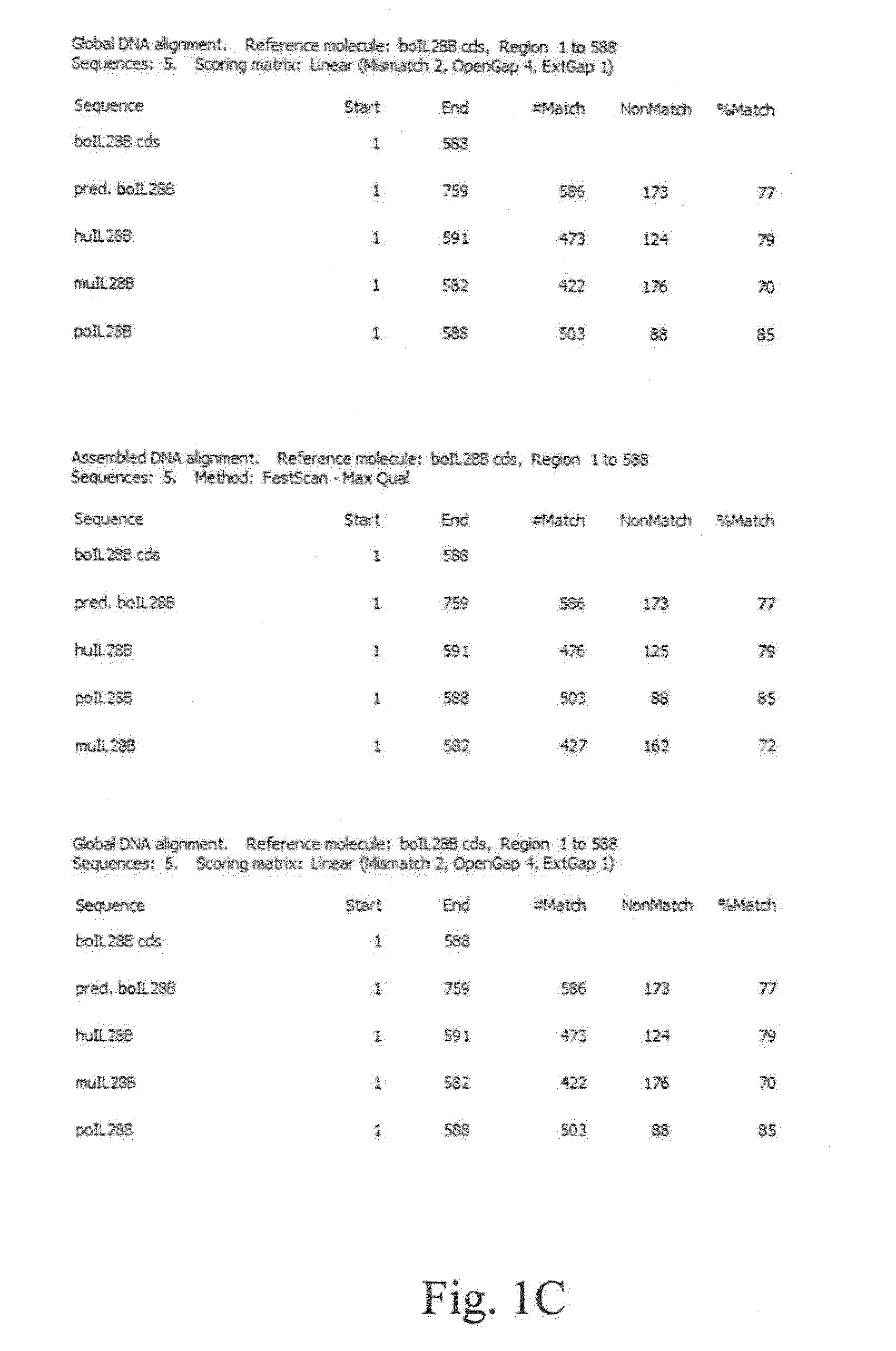Antiviral Activity of Bovine Type III Interferon Against Foot-and-Mouth Disease Virus
a technology of interferon and bovine type, applied in the field of antiviral activity of bovine type iii interferon against foot and mouth disease virus, can solve the problems of delayed disease, reduced clinical signs, and limitations of similar approaches, so as to reduce the severity of fmd, and reduce the degree or rate of infection.
- Summary
- Abstract
- Description
- Claims
- Application Information
AI Technical Summary
Benefits of technology
Problems solved by technology
Method used
Image
Examples
example 1
Cell Lines and Viruses
[0070]Human 293 cells (ATCC CRL-1573) were used to generate and propagate recombinant adenovirus. Embryonic bovine kidney (EBK) cells and porcine kidney cells (IB-R52) were obtained from the Foreign Animal Disease Diagnostic Laboratory (APHIS) at Plum Island Animal Disease Center (PIADC), Greenport, N.Y. Madin-Darby bovine kidney cells (MDBK, ATCC CCL-22) were purchased from the American Type Culture Collection (ATCC, Rockville, Md.). All cells were maintained in Eagle's minimal essential medium (EMEM) containing either 10% calf serum or 10% fetal bovine serum (FBS) supplemented with antibiotics. Baby hamster kidney cells (BHK-21, ATCC CCL-10) were used to propagate and titrate FMDV. These cells were maintained in EMEM containing 10% calf serum and 10% tryptose phosphate broth supplemented with antibiotics. FMDV subtype A12 was generated from the full-length infectious clone pRMC35 and used for the biologic assay of IFN. For cattle challenge, FMDV A24 Cruzeiro ...
example 2
Identification, Cloning and Expression of boIFN-λ3
[0071]RNA was isolated from EBK cells infected with an attenuated FMDV serotype A12 strain lacking the leader protein coding region (leaderless virus; Piccone et al. 1995. J. Virol. 69: 5376-82) at MOI 1 for 6 h, and using an RNeasy mini kit (Qiagen, Valencia, Calif.) following the manufacturer's directions. Approximately 1 μg of RNA was treated with DNase I (Sigma, St. Louis, Mo.) and was used to synthesize cDNA with M-MLV reverse transcriptase (Invitrogen) and random hexamers following the manufacturer's directions. Two oligonucleotides: 5′ATGGCCCCGGGCTG CACGCT 3′ (FW) (SEQ ID NO:12) and 5′TTAGACACACTGGTCTCCGCT GGC 3′ (RW) (SEQ ID NO:13) containing ClaI and XbaI restriction sites respectively were designed to amplify the putative IL28B sequence using the prepared bovine cDNA as template. The amplified PCR fragment was digested with ClaI and XbaI and cloned into the plasmid pAd5-Blue (Moraes et al. 2001. Bio Techniques 31: 1050-1056...
example 3
Antiviral Activity of boIFN-λ3
[0075]Antiviral activity was evaluated in plasma samples and nasal and oral swabs as described elsewhere (Chinsangaram et al. 2001, supra). Briefly, serial 2-fold dilutions of samples (ranging from 1 / 25 to 1 / 6,400), obtained at −1, 0 and 1 dpc, were incubated on MDBK cells. Twenty-four hours later, supernatants were removed, and the cells were infected for 1 h with approximately 100 PFU / ml of VSV. Cells were then overlaid with gum tragacanth and incubated for 48 h. Plaques were visualized by staining with crystal violet. Antiviral activity was determined as the reciprocal of the highest supernatant dilution that resulted in a 50% reduction in the number of plaques relative to the number of plaques in the untreated infected cells and results were expressed as units of antiviral activity / ml of sample.
[0076]In order to corroborate the predicted biochemical properties and determine if the identified boIFN-λ3 sequence encoded for a biologically active IFN pr...
PUM
| Property | Measurement | Unit |
|---|---|---|
| temperature | aaaaa | aaaaa |
| Tm | aaaaa | aaaaa |
| temperatures | aaaaa | aaaaa |
Abstract
Description
Claims
Application Information
 Login to View More
Login to View More - R&D
- Intellectual Property
- Life Sciences
- Materials
- Tech Scout
- Unparalleled Data Quality
- Higher Quality Content
- 60% Fewer Hallucinations
Browse by: Latest US Patents, China's latest patents, Technical Efficacy Thesaurus, Application Domain, Technology Topic, Popular Technical Reports.
© 2025 PatSnap. All rights reserved.Legal|Privacy policy|Modern Slavery Act Transparency Statement|Sitemap|About US| Contact US: help@patsnap.com



